Sundararaja D. The Discrete Fourier Transform. Theory, Algorithms and Applications
Подождите немного. Документ загружается.

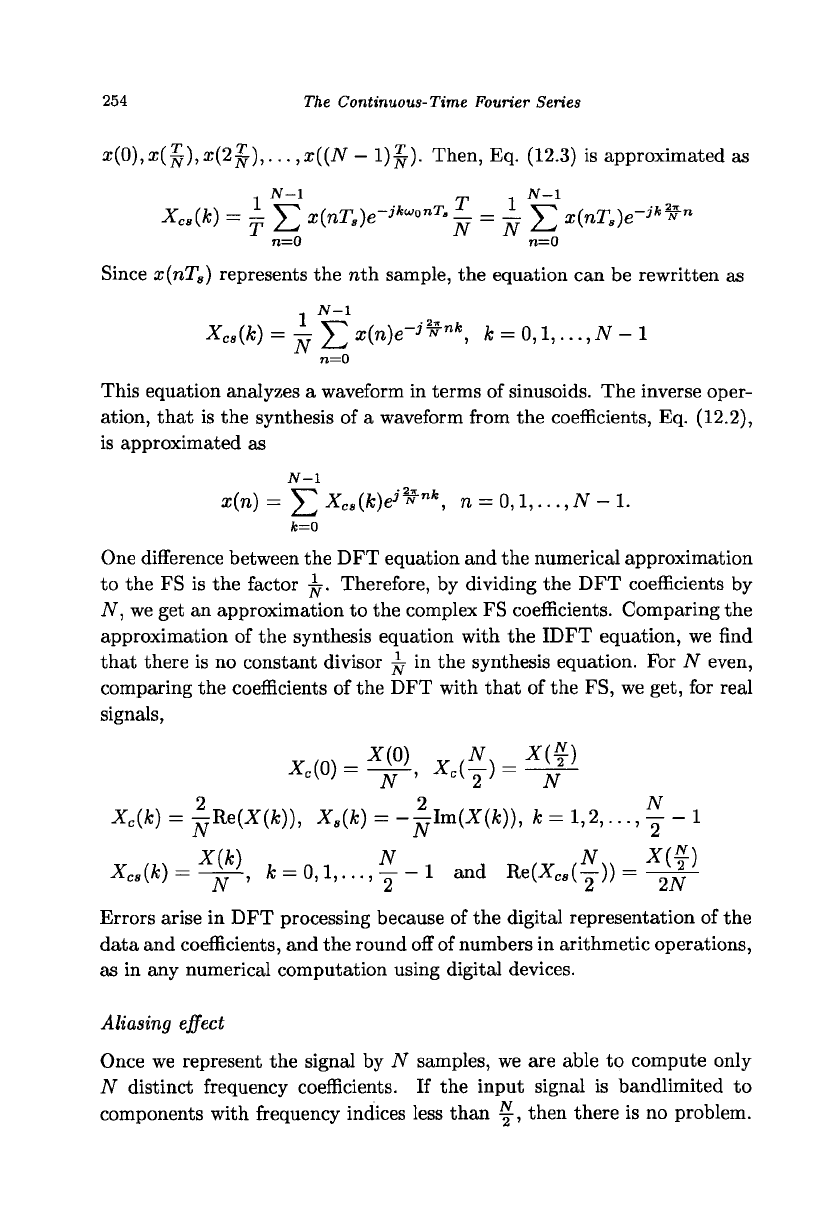
254
The Continuous-Time Fourier Series
x(0),x(£),x(2^),...,x((N-l)$). Then, Eq. (12.3) is approximated as
T *->
v
" N N
n=0 n=0
Since x(nT
s
) represents the nth sample, the equation can be rewritten as
1
JV_1
X
ca
(k)
= -
J
£x(n)e-
i¥nk
, k =
0,l,...,N-l
N
71=0
This equation analyzes a waveform in terms of sinusoids. The inverse oper-
ation, that is the synthesis of a waveform from the coefficients, Eq. (12.2),
is approximated as
JV-l
x(n) = Y,
X
cs
{k)e^
nk
,
n =
0,l,...,N-l.
One difference between the DFT equation and the numerical approximation
to the FS is the factor jj. Therefore, by dividing the DFT coefficients by
N, we get an approximation to the complex FS coefficients. Comparing the
approximation of the synthesis equation with the IDFT equation, we find
that there is no constant divisor ^ in the synthesis equation. For N even,
comparing the coefficients of the DFT with that of the FS, we get, for real
signals,
X
c
(k)
= |pRe(X(fc)), X
s
(k) = -^Im(X(k)), k =
1,2,...,
y - 1
X
cs
(k)
= ^-, * = 0,l,...,y-l and Re(X
cs
(^)) = ^
Errors arise in DFT processing because of the digital representation of the
data and coefficients, and the round off of numbers in arithmetic operations,
as in any numerical computation using digital devices.
Aliasing effect
Once we represent the signal by N samples, we are able to compute only
N distinct frequency coefficients. If the input signal is bandlimited to
components with frequency indices less than ^i then there is no problem.
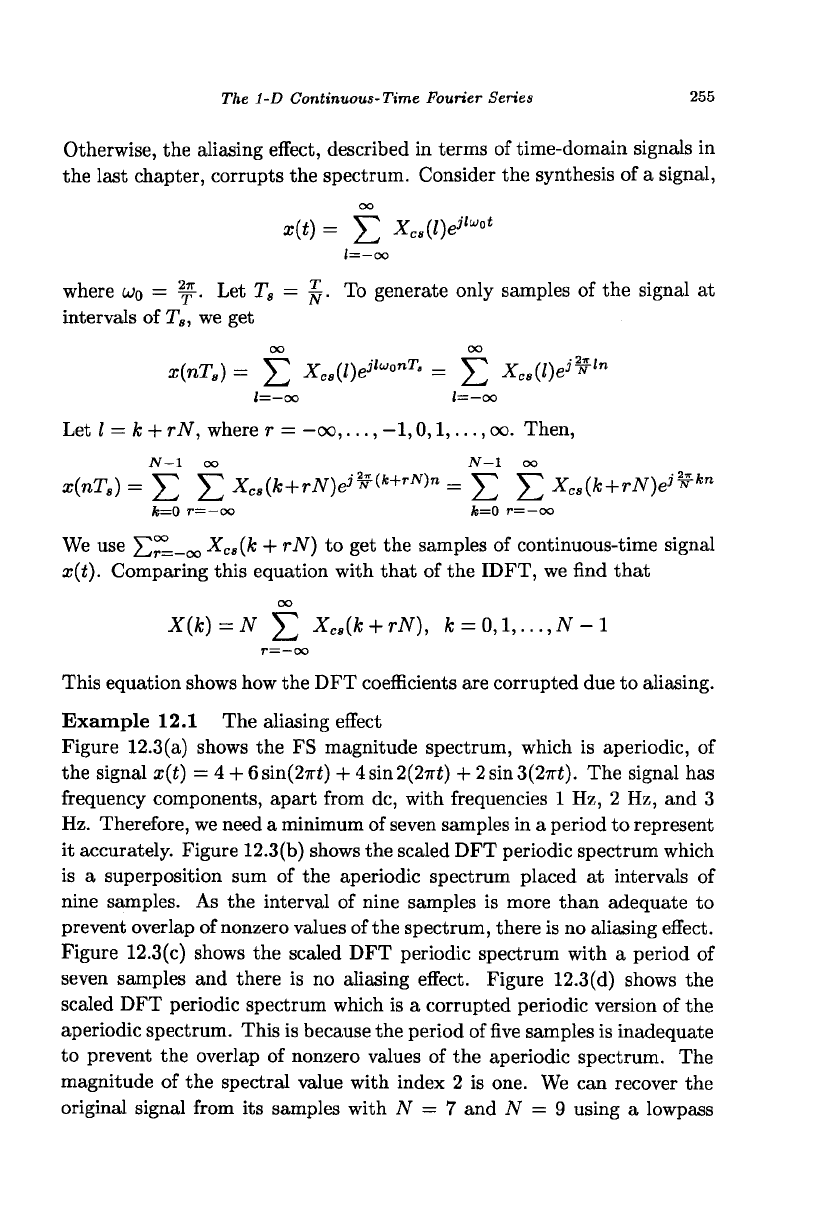
The 1-D Continuous-Time Fourier Series
255
Otherwise, the aliasing effect, described in terms of time-domain signals in
the last chapter, corrupts the spectrum. Consider the synthesis of a signal,
oo
x(t) =
Y,
Xcs(iw
laot
l=—oo
where u>o =
%jr.
Let T
s
— ]j. To generate only samples of the signal at
intervals of T
s
, we get
oo oo
x(nT
s
) = J2
X
ca
{l)e
iluonT
'
= £
X
e
.(I)e>*
,n
l=—oo l=—oo
Let I = k + rN, where r = —oo,...,
—1,0,1,...,
oo. Then,
JV-1 oo N-l oo
x
(nT
s
) = Y, J2 Xcs(k+rN)e
j
^
k+rN
)
n
= Y, H
X
C8
(k
+ rN)e
j
^
kn
k=0 r=—oo fc=0 r=—oo
We use X)^l-oo
X
cs
{k
+ rN) to get the samples of continuous-time signal
x(t).
Comparing this equation with that of the IDFT, we find that
oo
X(k) = N ]T
X
C8
(k
+ rN), fc = 0,1,...,JV-l
r= —oo
This equation shows how the DFT coefficients are corrupted due to aliasing.
Example 12.1 The aliasing effect
Figure 12.3(a) shows the FS magnitude spectrum, which is aperiodic, of
the signal x(t) =4 + 6 sin(27r£) + 4 sin 2(27ri) +
2
sin
3(27ri).
The signal has
frequency components, apart from dc, with frequencies 1 Hz, 2 Hz, and 3
Hz. Therefore, we need a minimum of seven samples in a period to represent
it accurately. Figure 12.3(b) shows the scaled DFT periodic spectrum which
is a superposition sum of the aperiodic spectrum placed at intervals of
nine samples. As the interval of nine samples is more than adequate to
prevent overlap of nonzero values of the spectrum, there is no aliasing effect.
Figure 12.3(c) shows the scaled DFT periodic spectrum with a period of
seven samples and there is no aliasing effect. Figure 12.3(d) shows the
scaled DFT periodic spectrum which is a corrupted periodic version of the
aperiodic spectrum. This is because the period of five samples is inadequate
to prevent the overlap of nonzero values of the aperiodic spectrum. The
magnitude of the spectral value with index 2 is one. We can recover the
original signal from its samples with N = 7 and N = 9 using a lowpass
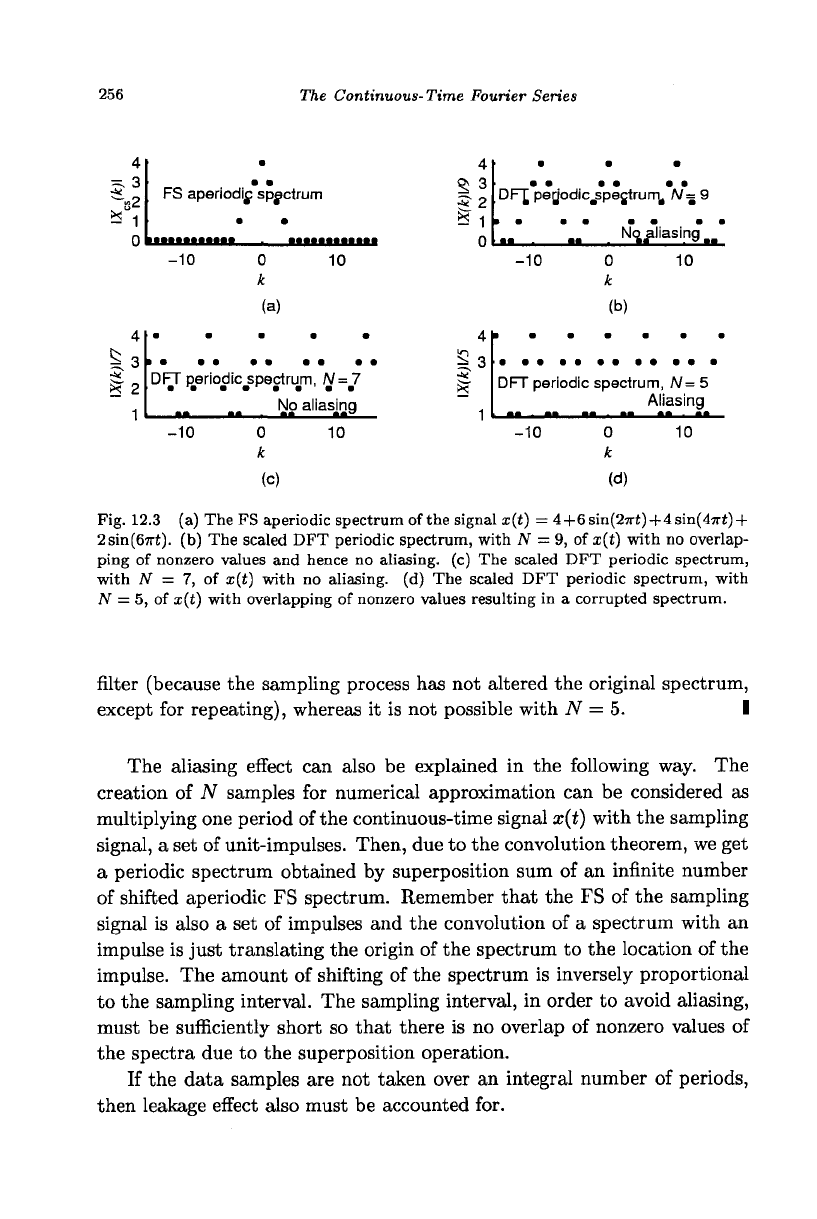
256
The Continuous-Time Fourier Series
4
"B2
X
FS aperiodij spgctrum
4
S 2
* 1
• • • • • •
DFT,
pegodic^spejtrurr^ /V= 9
U
aliasing ..
-10
0
k
(a)
10 -10
0
k
(b)
10
^3
& 2
1
DFT periodic spectrum, N = 7
No aliasinq
4
§.3
1
DFT periodic spectrum, N= 5
Aliasing
-10
0
k
(c)
10
-10
0
k
(d)
10
Fig. 12.3 (a) The FS aperiodic spectrum of the signal x(t) = 4 + 6sin(27rt)-f 4 sin(4n-t)+
2sin(67rt). (b) The scaled DFT periodic spectrum, with N = 9, of i(t) with no overlap-
ping of nonzero values and hence no aliasing, (c) The scaled DFT periodic spectrum,
with N = 7, of x(t) with no aliasing, (d) The scaled DFT periodic spectrum, with
N = 5, of x(t) with overlapping of nonzero values resulting in a corrupted spectrum.
filter (because the sampling process has not altered the original spectrum,
except for repeating), whereas it is not possible with N = 5. I
The aliasing effect can also be explained in the following way. The
creation of N samples for numerical approximation can be considered as
multiplying one period of the continuous-time signal x(t) with the sampling
signal, a set of unit-impulses. Then, due to the convolution theorem, we get
a periodic spectrum obtained by superposition sum of an infinite number
of shifted aperiodic FS spectrum. Remember that the FS of the sampling
signal is also a set of impulses and the convolution of a spectrum with an
impulse is just translating the origin of the spectrum to the location of the
impulse. The amount of shifting of the spectrum is inversely proportional
to the sampling interval. The sampling interval, in order to avoid aliasing,
must be sufficiently short so that there is no overlap of nonzero values of
the spectra due to the superposition operation.
If the data samples are not taken over an integral number of periods,
then leakage effect also must be accounted for.
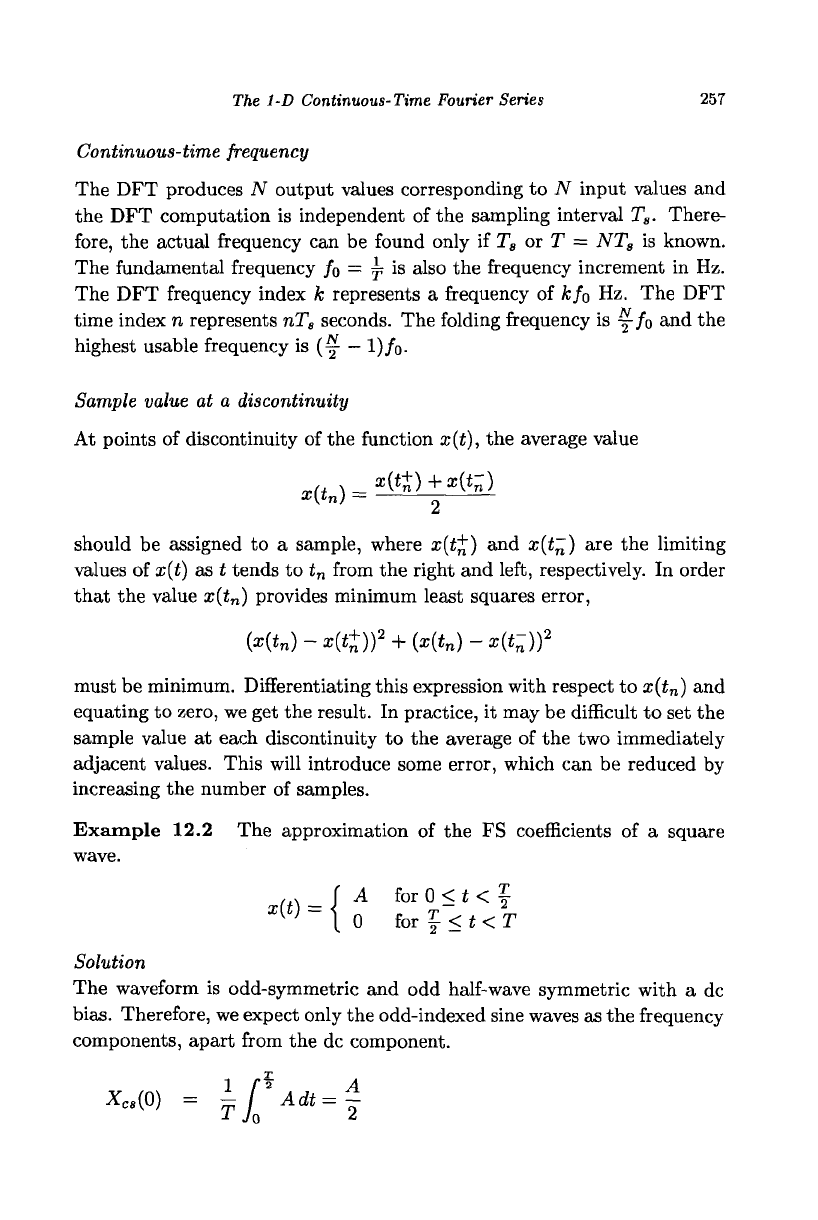
The 1-D Continuous-Time Fourier Series 257
Continuous-time frequency
The DFT produces N output values corresponding to N input values and
the DFT computation is independent of the sampling interval T
s
. There-
fore,
the actual frequency can be found only if T
s
or T = NT
S
is known.
The fundamental frequency /o = ^ is also the frequency increment in Hz.
The DFT frequency index k represents a frequency of A;/
0
Hz. The DFT
time index n represents nT
s
seconds. The folding frequency is y/
0
and the
highest usable frequency is (y - l)/o.
Sample value at a discontinuity
At points of discontinuity of the function x(t), the average value
should be assigned to a sample, where x(t+) and x{t~) are the limiting
values of x(t) as t tends to t
n
from the right and left, respectively. In order
that the value x(t
n
) provides minimum least squares error,
(x(t
n
)-x(tt))
2
+ (x(t
n
)-x(t-))
2
must be minimum. Differentiating this expression with respect to x(t
n
) and
equating to zero, we get the result. In practice, it may be difficult to set the
sample value at each discontinuity to the average of the two immediately
adjacent values. This will introduce some error, which can be reduced by
increasing the number of samples.
Example 12.2 The approximation of the FS coefficients of a square
wave.
x(t) = |
A for 0 < t < £
0 for
y
< t < T
Solution
The waveform is odd-symmetric and odd half-wave symmetric with a dc
bias.
Therefore, we expect only the odd-indexed sine waves as the frequency
components, apart from the dc component.
1 /"= A
Xcs(0) = -J
o
Adt=-
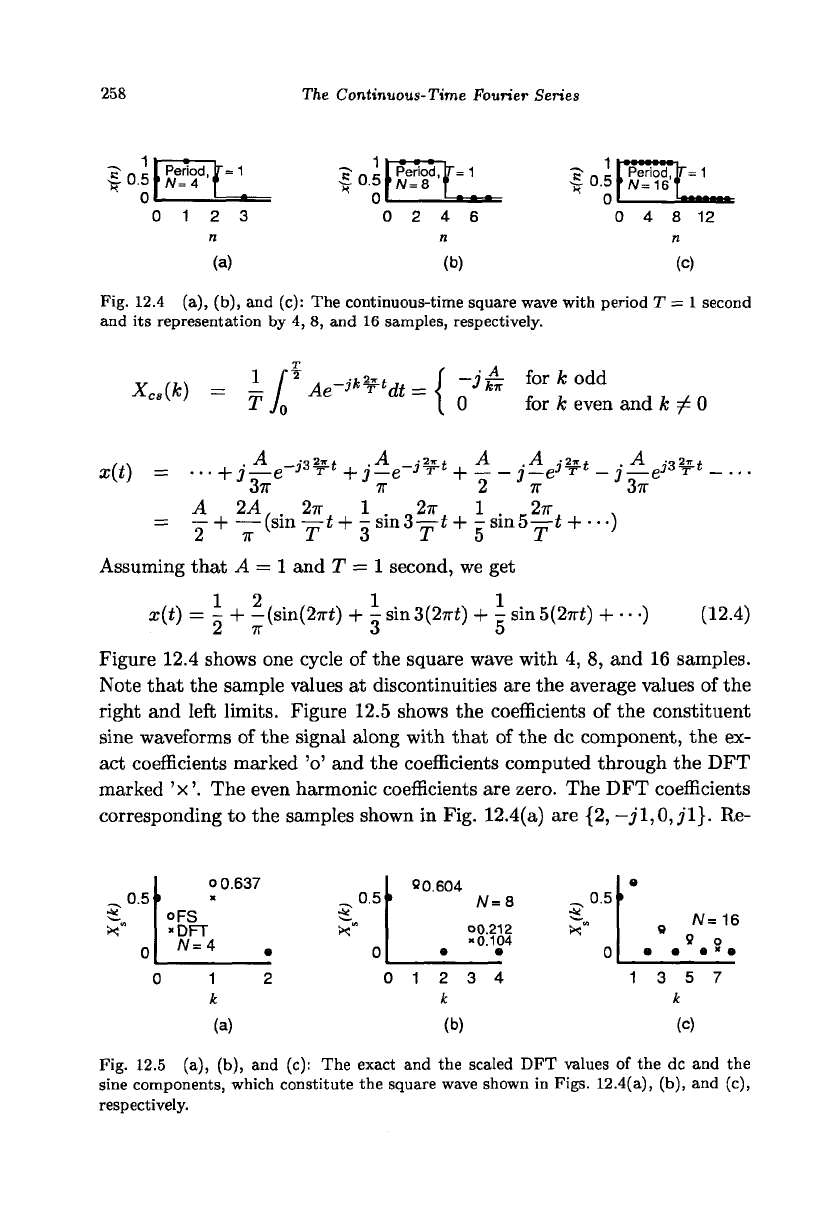
258
The Continuous- Time Fourier Series
•5-
_
K
, Period, IT =1
•g.
0.5 '/v=4 >
"?
nK
Period T=1
0 2 4 6
(b)
io.;
• IMIMI
„ Period, r= 1
'W=16"
0 4 8 12
(c)
Fig. 12.4 (a), (b), and (c): The continuous-time square wave with period T = 1 second
and its representation by 4, 8, and 16 samples, respectively.
X (k) - - r Ae-f^dt-i ~
j
£
hrkodd
X
cs
{k)
-
r
^ Ae
dt
-\
Q iolk ever
even and k ^0
37T
7T 2
24,
. 2?r 1 . 2TT 1 . 2TT
+ —(sin— i+-sm3—i+-sin5—< + •••)
x(t) = hj—e
~ 2
+
7T
lSm
r' ' 3"~T' ' 5"""T
Assuming that A = 1 and T = 1 second, we get
J'
V ' -|- " j — g^ V
*
j g^ T *
A „-2*
—<
7T
12 1 1
a:(t) = - + -(sin(27rt) + - sin3(27rf) + - sin5(27ri) +
• •
•) (12.4)
2 7r 3 5
Figure 12.4 shows one cycle of the square wave with 4, 8, and 16 samples.
Note that the sample values at discontinuities are the average values of the
right and left limits. Figure 12.5 shows the coefficients of the constituent
sine waveforms of the signal along with that of the dc component, the ex-
act coefficients marked 'o' and the coefficients computed through the DFT
marked 'x'. The even harmonic coefficients are zero. The DFT coefficients
corresponding to the samples shown in Fig. 12.4(a) are {2, —
j'1,0,,7'1}.
Re-
0.5
>
0 0.637
oFS
»DFT
A/=4
0.5
^
*"
00.604
W=8
00.212
»0.104
0 1
2
k
(b)
3 4
0.5
„ A/=16
° 9 o
• • • " •
13 5 7
k
(c)
Fig. 12.5 (a), (b), and (c): The exact and the scaled DFT values of the dc and the
sine components, which constitute the square wave shown in Figs. 12.4(a), (b), and (c),
respectively.
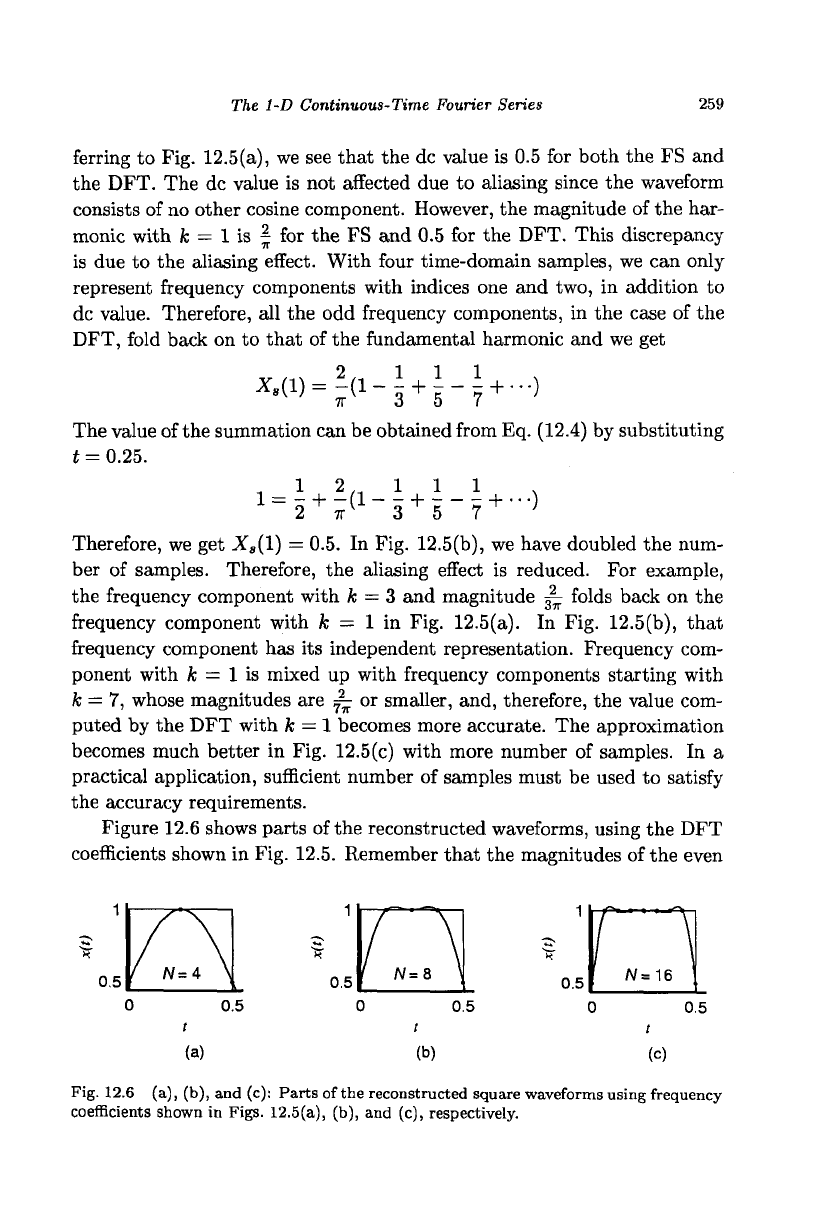
The 1-D Continuous-Time. Fourier Series 259
ferring to Fig. 12.5(a), we see that the dc value is 0.5 for both the FS and
the DFT. The dc value is not affected due to aliasing since the waveform
consists of no other cosine component. However, the magnitude of the har-
monic with k = 1 is \ for the FS and 0.5 for the DFT. This discrepancy
is due to the aliasing effect. With four time-domain samples, we can only
represent frequency components with indices one and two, in addition to
dc value. Therefore, all the odd frequency components, in the case of the
DFT, fold back on to that of the fundamental harmonic and we get
The value of the summation can be obtained from Eq. (12.4) by substituting
t = 0.25.
-, 1 2„ 1 1 1
^S
+
^-a
+
s-^-)
Therefore, we get X
s
(l) = 0.5. In Fig. 12.5(b), we have doubled the num-
ber of samples. Therefore, the aliasing effect is reduced. For example,
the frequency component with k = 3 and magnitude ^ folds back on the
frequency component with k = 1 in Fig. 12.5(a). In Fig. 12.5(b), that
frequency component has its independent representation. Frequency com-
ponent with ifc = 1 is mixed up with frequency components starting with
k = 7, whose magnitudes are ^ or smaller, and, therefore, the value com-
puted by the DFT with k = 1 becomes more accurate. The approximation
becomes much better in Fig. 12.5(c) with more number of samples. In a
practical application, sufficient number of samples must be used to satisfy
the accuracy requirements.
Figure 12.6 shows parts of the reconstructed waveforms, using the DFT
coefficients shown in Fig. 12.5. Remember that the magnitudes of the even
f
N
=* \
0
,
5
r
N=a
\
0
,
5
f "-is
0 0.5 0 0.5 0 0.5
i t t
(a) (b) (c)
Fig. 12.6 (a), (b), and (c): Parts of the reconstructed square waveforms using frequency
coefficients shown in Figs. 12.5(a), (b), and (c), respectively.
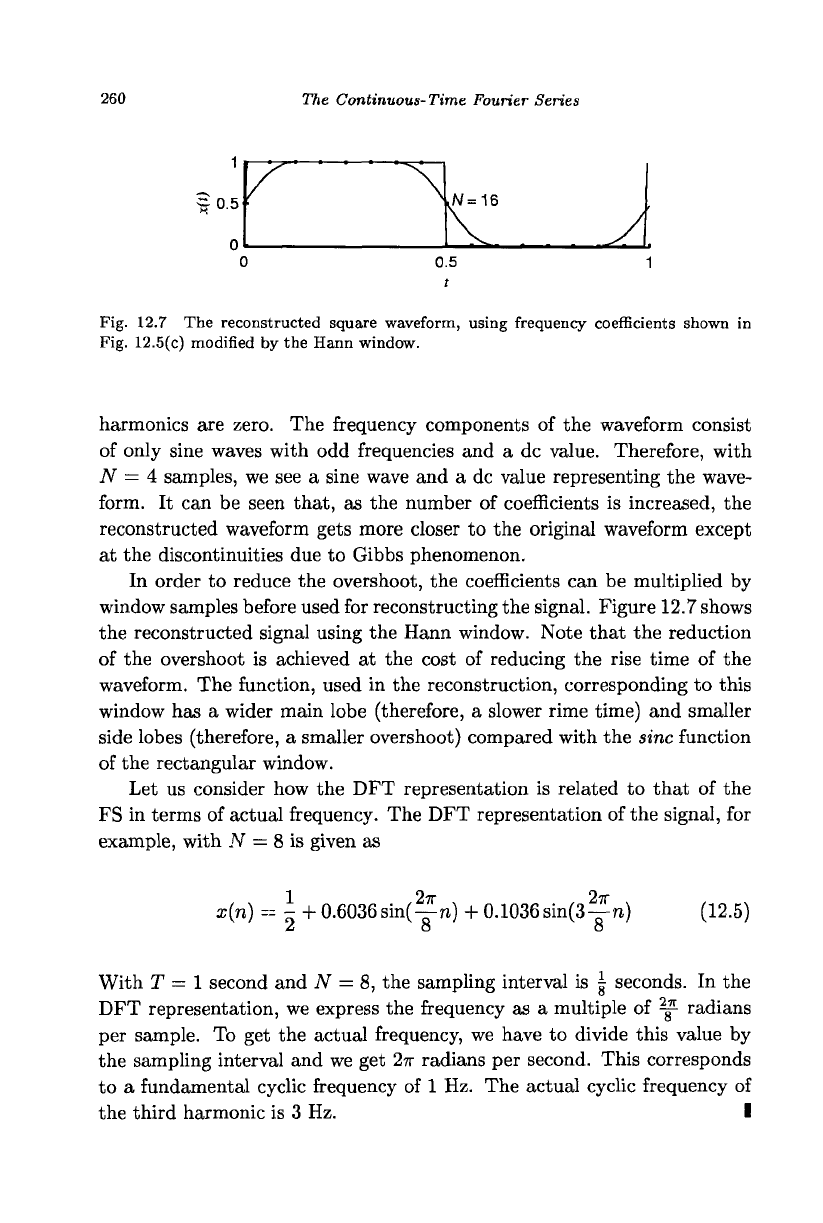
260 The Continuous- Time Fourier Series
1
S0.5
0
0 0.5 1
t
Fig. 12.7 The reconstructed square waveform, using frequency coefficients shown in
Fig. 12.5(c) modified by the Hann window.
harmonics are zero. The frequency components of the waveform consist
of only sine waves with odd frequencies and a dc value. Therefore, with
TV = 4 samples, we see a sine wave and a dc value representing the wave-
form. It can be seen that, as the number of coefficients is increased, the
reconstructed waveform gets more closer to the original waveform except
at the discontinuities due to Gibbs phenomenon.
In order to reduce the overshoot, the coefficients can be multiplied by
window samples before used for reconstructing the signal. Figure 12.7 shows
the reconstructed signal using the Hann window. Note that the reduction
of the overshoot is achieved at the cost of reducing the rise time of the
waveform. The function, used in the reconstruction, corresponding to this
window has a wider main lobe (therefore, a slower rime time) and smaller
side lobes (therefore, a smaller overshoot) compared with the sine function
of the rectangular window.
Let us consider how the DFT representation is related to that of the
FS in terms of actual frequency. The DFT representation of the signal, for
example, with N = 8 is given as
1
2TT 2TT
x(n) = -+ 0.6036 sin(-n) + 0.1036 sin(3—n) (12.5)
2 8 8
With T = 1 second and N = 8, the sampling interval is | seconds. In the
DFT representation, we express the frequency as a multiple of ^ radians
per sample. To get the actual frequency, we have to divide this value by
the sampling interval and we get
2TT
radians per second. This corresponds
to a fundamental cyclic frequency of 1 Hz. The actual cyclic frequency of
the third harmonic is 3 Hz. I
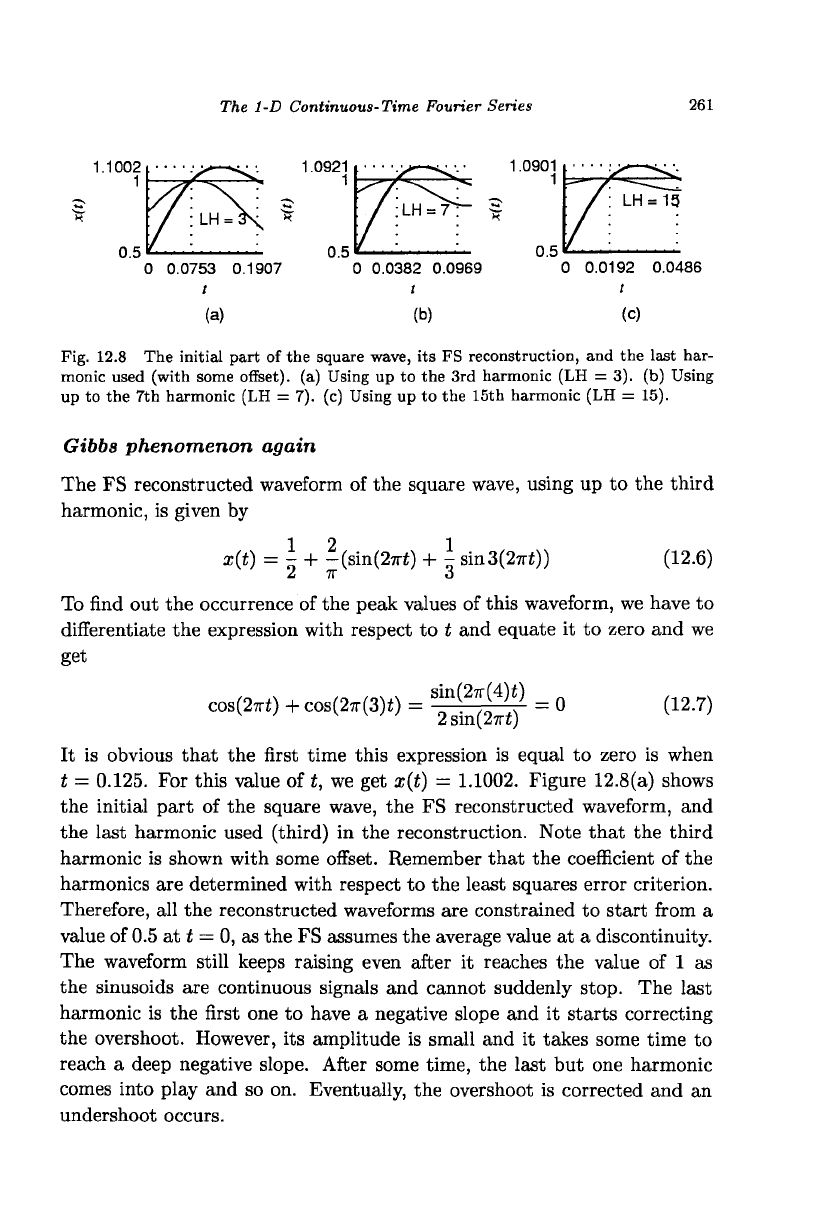
The 1-D Continuous-Time Fourier Series
261
1.1002
1
0.5
LH
1.0901
1
0.5
LH = 13
0 0.0753 0.1907 0 0.0382 0.0969
t
0 0.0192 0.0486
t
(b)
Fig. 12.8 The initial part of the square wave, its FS reconstruction, and the last har-
monic used (with some offset), (a) Using up to the 3rd harmonic (LH = 3). (b) Using
up to the 7th harmonic (LH = 7). (c) Using up to the 15th harmonic (LH = 15).
Gibbs phenomenon again
The FS reconstructed waveform of the square wave, using up to the third
harmonic, is given by
12 1
x(t) = - + -(sin(27rf) + - sin3(27ri))
2
7T 3
(12.6)
To find out the occurrence of the peak values of this waveform, we have to
differentiate the expression with respect to t and equate it to zero and we
get
cos(2
7ri
)+cos(2
7
r(3)i) = ^glM
=
0 (12.7)
It is obvious that the first time this expression is equal to zero is when
t = 0.125. For this value of t, we get x(t) =
1.1002.
Figure 12.8(a) shows
the initial part of the square wave, the FS reconstructed waveform, and
the last harmonic used (third) in the reconstruction. Note that the third
harmonic is shown with some offset. Remember that the coefficient of the
harmonics are determined with respect to the least squares error criterion.
Therefore, all the reconstructed waveforms are constrained to start from a
value of 0.5 at t = 0, as the FS assumes the average value at a discontinuity.
The waveform still keeps raising even after it reaches the value of 1 as
the sinusoids are continuous signals and cannot suddenly stop. The last
harmonic is the first one to have a negative slope and it starts correcting
the overshoot. However, its amplitude is small and it takes some time to
reach a deep negative slope. After some time, the last but one harmonic
comes into play and so on. Eventually, the overshoot is corrected and an
undershoot occurs.
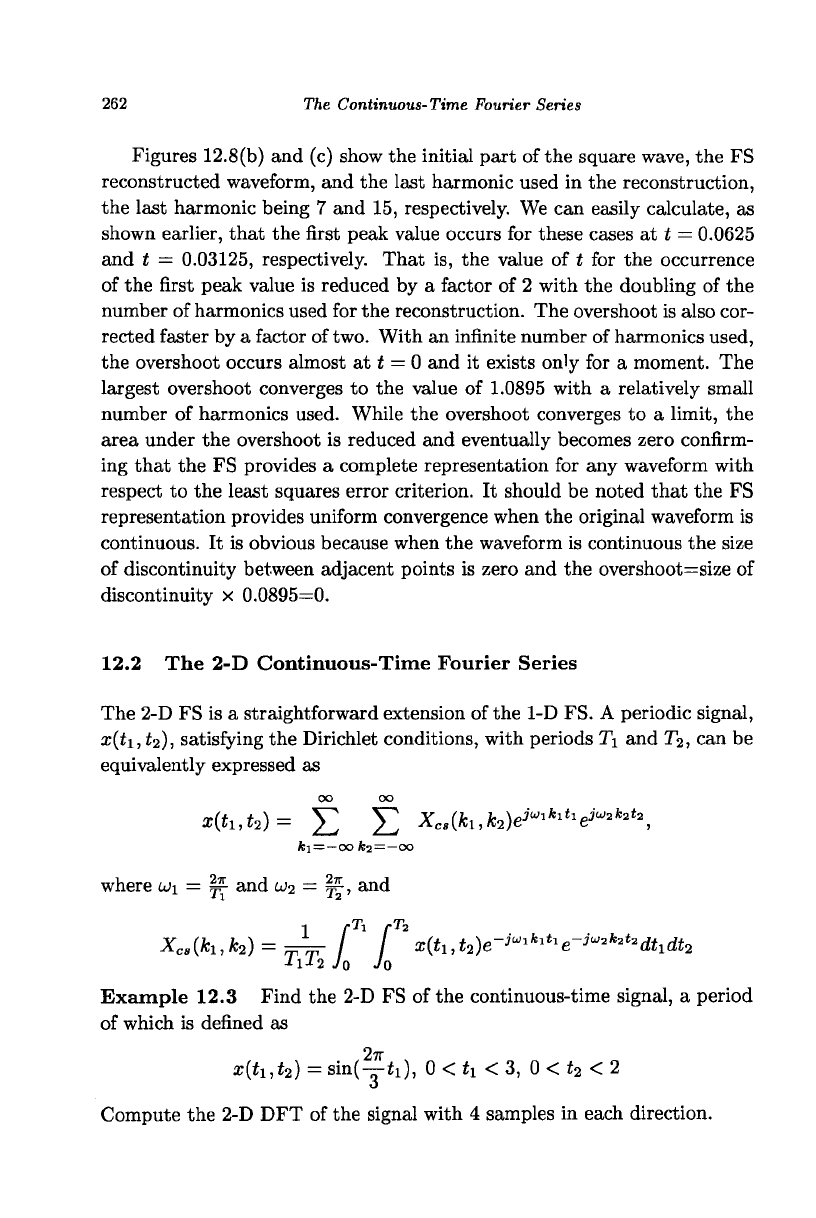
262
The Continuous-Time Fourier Series
Figures 12.8(b) and (c) show the initial part of the square wave, the FS
reconstructed waveform, and the last harmonic used in the reconstruction,
the last harmonic being 7 and 15, respectively. We can easily calculate, as
shown earlier, that the first peak value occurs for these cases at t = 0.0625
and t = 0.03125, respectively. That is, the value of t for the occurrence
of the first peak value is reduced by a factor of 2 with the doubling of the
number of harmonics used for the reconstruction. The overshoot is also cor-
rected faster by a factor of
two.
With an infinite number of harmonics used,
the overshoot occurs almost at t = 0 and it exists only for a moment. The
largest overshoot converges to the value of
1.0895
with a relatively small
number of harmonics used. While the overshoot converges to a limit, the
area under the overshoot is reduced and eventually becomes zero confirm-
ing that the FS provides a complete representation for any waveform with
respect to the least squares error criterion. It should be noted that the FS
representation provides uniform convergence when the original waveform is
continuous. It is obvious because when the waveform is continuous the size
of discontinuity between adjacent points is zero and the overshoot=size of
discontinuity x 0.0895=0.
12.2 The 2-D Continuous-Time Fourier Series
The 2-D FS is a straightforward extension of the 1-D FS. A periodic signal,
x(ti, t
2
), satisfying the Dirichlet conditions, with periods T\ and T
2
, can be
equivalently expressed as
00 00
x(h,t
2
) = Y, E X
C8
(kx,k
2
)e
jmkltl
e
juJ2k2t
\
where wi = §£ and
W2
= §£, and
X
c
.(*i,fe) = =V f ' f
^
x{t
u
t
2
)e-^
k
^e-^
k
^dt
l
dt
2
J1J2 Jo Jo
Example 12.3 Find the 2-D FS of the continuous-time signal, a period
of which is defined as
2ir
x{h,t
2
) = sin(—ti), 0 < h < 3, 0 < t
2
< 2
o
Compute the 2-D DFT of the signal with 4 samples in each direction.
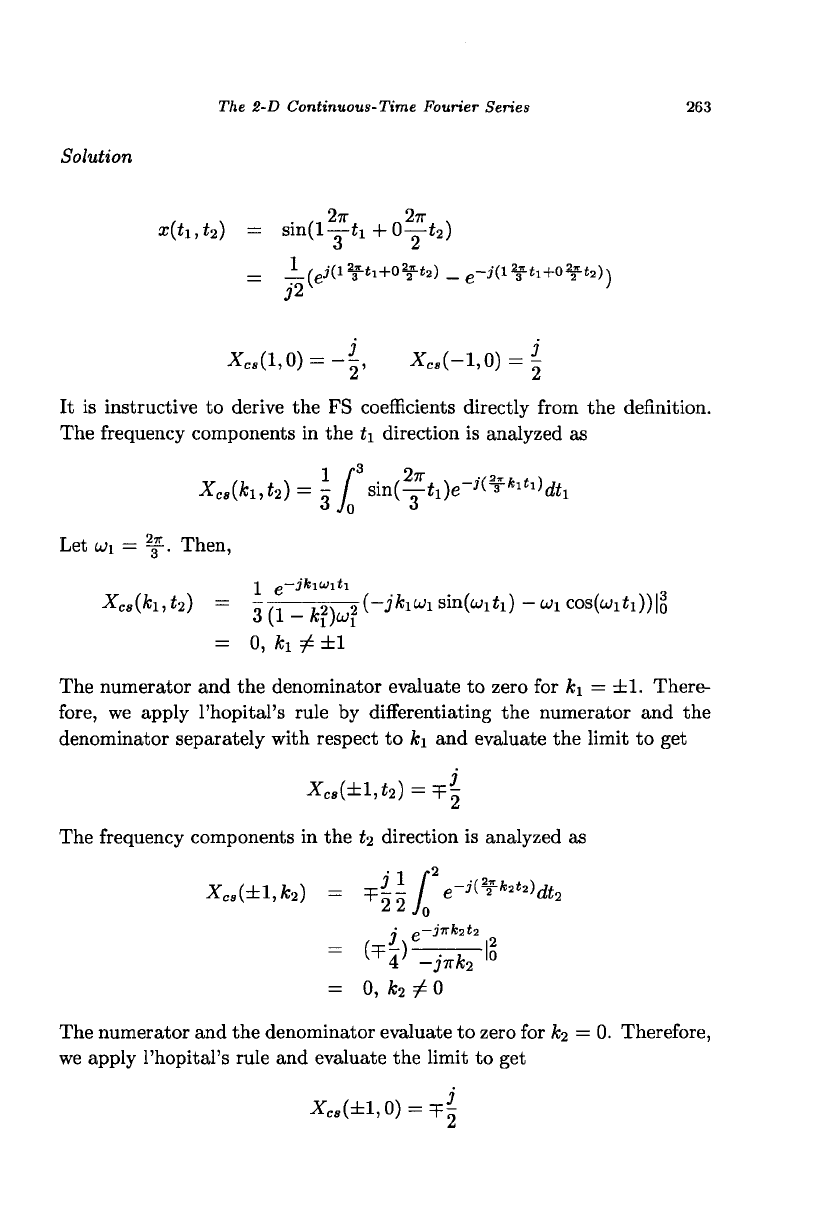
The 2-D Continuous-Time Fourier Series
263
Solution
. ,, 27r 2TT .
X{tl,t
2
) = Bin(lyti+Oyta)
j2^
;
^e.(l,0) = -|, X
cg
(-l,0) = |
It is instructive to derive the FS coefficients directly from the definition.
The frequency components in the h direction is analyzed as
x
c8
(kut2)
=
lj
sin
(y*i)
e_j(¥fclil)di
i
Let wi = ?f. Then,
\ g—jkiuiti
X
C8
{k±,t
2
)
= 3 /-. _
k
2\
2
(~J
fc
i"i
sin(o;iti) - ui cos(aJiti))|jj
= 0, fa ^ ±1
The numerator and the denominator evaluate to zero for fa = ±1. There-
fore,
we apply l'hopital's rule by differentiating the numerator and the
denominator separately with respect to fa and evaluate the limit to get
X
ca
(±l,t
2
)
= T^
The frequency components in the t
2
direction is analyzed as
(^7>
J\^_ |2
i' -J7Tk
2
'°
= 0, k
2
# 0
The numerator and the denominator evaluate to zero for k
2
= 0. Therefore,
we apply l'hopital's rule and evaluate the limit to get
X„(±1,0) = ^
